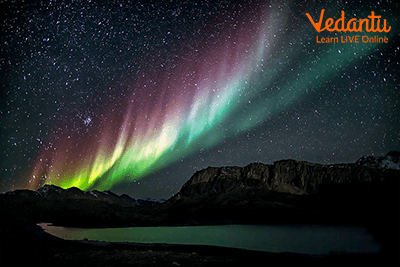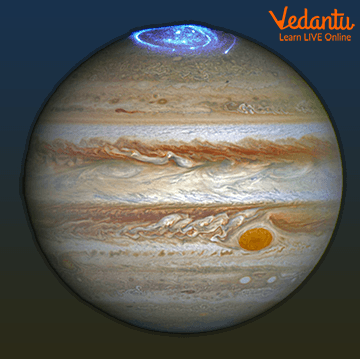




Northern Lights: An Overview
An aurora borealis, also known as polar lights or northern and southern lights, is a natural display in earth's sky, seen in high latitude regions such as the Arctic and Antarctic. It displays vibrant lights that resemble curtains, spirals, rays that cover and flicker over the sky. These 'northern' and 'southern lights' have fascinated, frightened, and inspired humans for centuries. More recently, photographers have gone to remarkable lengths to try and capture the beauty of these atmospheric events.
The lights we see in the night sky are in actual fact caused by activity on the surface of the Sun. Different gases give off different colours when they are heated. The same process is also taking place in the aurora. The two primary gases in the Earth’s atmosphere are nitrogen and oxygen, and these elements give off different colours during an aurora display.

Northern Lights
Facts About Northern Lights
Let's learn some facts about Aurora Borealis.
The Northern Lights Feature in Norse Mythology
Norse legend has it that the lights are reflections from the armour and shield of the great Valkyries. These great female warriors would choose which of the fallen warriors would gain their entry to Valhalla (heaven for the warriors and gods).
Japanese Culture Associates Aurora With Luck
The aurora legends also include fertility! In Japanese culture for example, a child conceived during a northern lights display will be blessed with good looks, intellect, and good fortune.
The Northern Lights are Only Visible When It's Dark, But They Can Occur At Any Time
Contrary to what some people think, the aurora borealis can occur at any time of day. However, our eyes need darkness to be able to perceive them. This means that the days around a full moon are not the best for hunting the lights.
The First Aurora Photograph Was Taken More Than 125 Years Ago
It was German physicist and astronomer Otto Rudolf Martin Brendel (1862–1939) who took the first known photograph of the aurora borealis.
The Northern Lights Occur Around 100km Above the Earth
According to Norway's UiT, the lights are generally found between 90km and 130 km above ground level, although they can be even higher and can be stretched a bit more.
Interesting Facts about Northern Lights for Kids
They are Visible From Space
Satellites are able to take pictures of the aurora from the Earth's orbit. In fact, auroras are bright enough that they are visible on the nightside of the Earth from another planet too.
The Lights Can Move South
Occasionally, the auroras are visible farther from the poles than usual. In times of high solar activity, the southern limit for seeing auroras can go as far south as Oklahoma and Atlanta as it did in October 2011.
They Look Like Cold Fire
The northern lights look like fire, but they wouldn't feel like one. Even though the temperature of the upper atmosphere can reach thousands of degrees Fahrenheit, the heat is based on the average speed of the molecules.
Other Planets Also Have Aurora Lights
Auroras on either Jupiter or Saturn are much larger and more powerful than on Earth because those planets have magnetic fields much stronger and of much larger magnitude.

Aurora Lights
Solved Questions
What causes the northern lights?
Ans: Atoms and molecules in our atmosphere collide with particles from the Sun. The aurora's characteristic wavy patterns and 'curtains' of light are caused by the lines of force in the Earth's magnetic field.
Why do northern lights occur?
Ans: The magnetic field of Earth will deflect the electrons. With the deflection of the magnetic field, electrons move around the planet and occur near the polar regions where the magnetic field is comparatively weak.
What did ancient people think of Northern lights?
Ans: The Ancient Romans believed the Aurora Borealis was the physical manifestation of Aurora, who was their Goddess of the Dawn.
Learning by Doing
Aurora lights are related to which mythology?
Hindu
Greek
Norse
French
Northern lights are also known as
Aurora borealis
Aurora waalis
Dormammu
Godwallis
Summary
The northern lights also known as the aurora borealis are the beautiful dancing waves of light. It displays vibrant lights that resemble curtains, spirals, rays that cover and flicker over the sky. The two primary gases in the Earth’s atmosphere are nitrogen and oxygen, and these elements give off different colours during an aurora display. Norse legend has it that the lights are reflections from the armour and shield of the great Valkyries. Auroras on either Jupiter or Saturn are much larger and more powerful than on Earth.
FAQs on Northern Lights Facts
1. What causes the Northern Lights?
The Northern Lights, or Aurora Borealis, are caused by a fascinating interaction between the Sun and Earth. It starts when the Sun releases a stream of charged particles, known as the solar wind. These particles travel through space and are guided by the Earth's magnetic field towards the polar regions. When they collide with gases like oxygen and nitrogen in our upper atmosphere, they release energy in the form of beautiful, colourful light.
2. Why do the Northern Lights have different colours?
The colours of the Northern Lights depend on two main factors: the type of gas particles the solar wind collides with and the altitude of these collisions. The most common colours are:
- Green: Produced by oxygen particles at an altitude of about 100 to 300 km.
- Pink or Red: Caused by nitrogen particles at lower altitudes (below 100 km).
- All-Red: A rare colour produced by oxygen at very high altitudes (above 300 km).
- Blue or Purple: Sometimes seen at the lower edges of the aurora, caused by nitrogen particles.
3. In which countries can you see the Northern Lights?
The Northern Lights are best viewed from locations within the 'auroral zone', which is a ring-shaped area around the Earth's magnetic North Pole. The top countries to witness this natural wonder include Norway, Sweden, Finland, Iceland, Greenland, Canada (especially the northern parts), and Alaska (USA).
4. Why are the Northern Lights also called 'Aurora Borealis'?
The name 'Aurora Borealis' has historical roots. 'Aurora' was the name of the Roman goddess of the dawn. The word 'Borealis' is Latin for 'northern'. When put together, 'Aurora Borealis' translates to 'Northern Dawn'. This name was given because the lights often look like a colourful sunrise appearing in the north.
5. Can we see the Northern Lights from India? Why or why not?
No, it is not possible to see the Northern Lights from India. The phenomenon is tied to the Earth's magnetic poles. The charged particles from the sun are funnelled by the magnetic field to the far north and south of the planet. India's geographical location is too close to the equator and far away from the North Pole's auroral zone, making it impossible to see the lights.
6. Are the Northern Lights always present, even if we can't see them?
The interaction between the solar wind and Earth's atmosphere that causes the aurora is a nearly continuous process. However, seeing the lights from the ground requires specific conditions. We need complete darkness, which is why they are not visible during the day. We also need clear, cloudless skies. So, while the scientific phenomenon may be occurring, our ability to witness it is limited to dark, clear nights in polar regions.
7. How are the Northern Lights different from the Southern Lights?
The Northern Lights (Aurora Borealis) and Southern Lights (Aurora Australis) are essentially the same phenomenon occurring in opposite hemispheres. They are like mirror images of each other. Both are created by the solar wind interacting with the Earth's magnetic field. The only real difference is their location: the Aurora Borealis is seen in the Northern Hemisphere, while the Aurora Australis is seen in the Southern Hemisphere, primarily over Antarctica and parts of Australia and New Zealand.
8. What is the best time to see the Northern Lights?
The best time of year to see the Northern Lights is during the winter months in the Northern Hemisphere, typically from late September to early April. This period offers the longest and darkest nights, which are essential for viewing the aurora. The peak viewing hours are usually between 10 PM and 2 AM local time.









